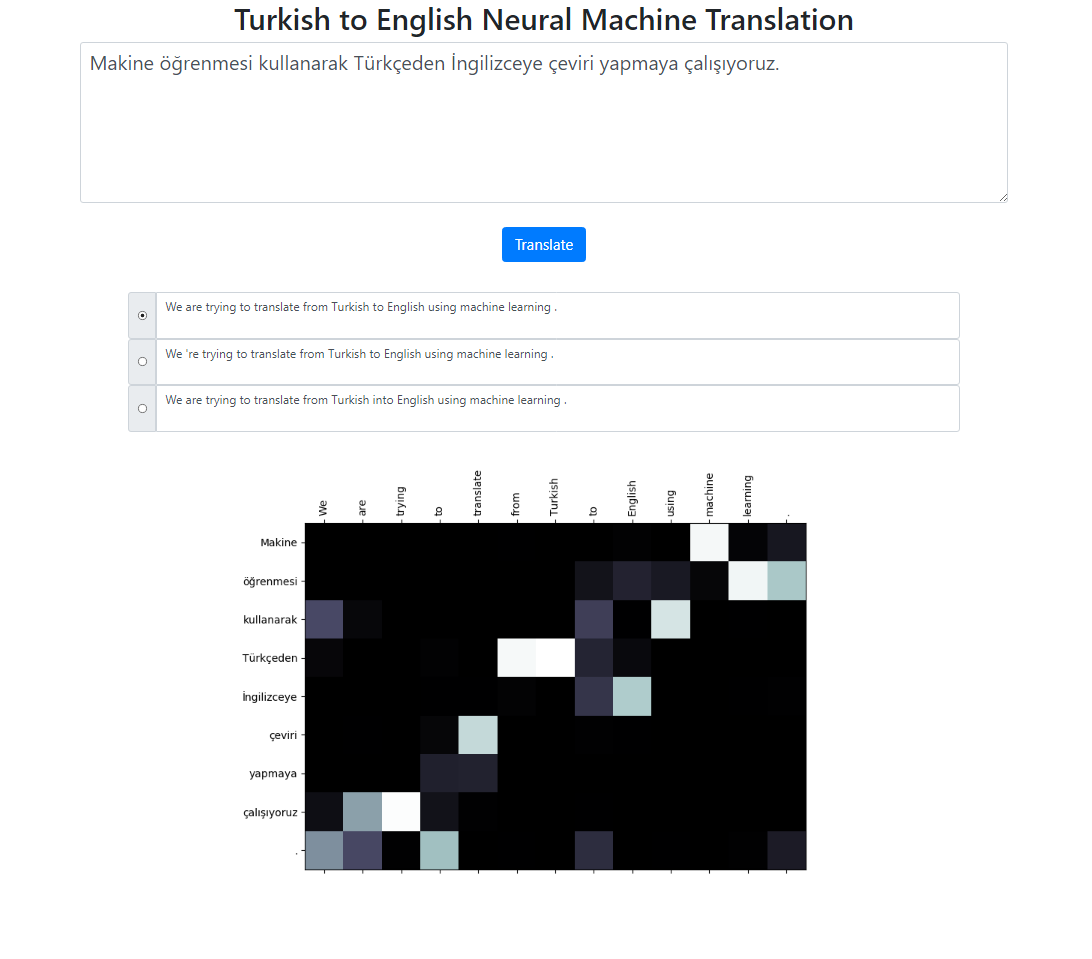This repository implements a Turkish to English Neural Machine Translation system using Seq2Seq + Global Attention model. There is also a Flask application that you can run locally. You can enter the text, translate and, inspect the results as well as the attention visualization. We run beam search with beam size 3 in the background and return the most probable sequences sorted by their relative score.
The dataset for this project is taken from here. I have used the Tatoeba corpus. I have deleted some of the duplicates found in the data. I also pretokenized the dataset. Finalized version can be found in data folder.
- For tokenizing the Turkish sentences, I've used the nltk's RegexpTokenizer.
puncts_except_apostrophe = '!"#$%&\()*+,-./:;<=>?@[\\]^_`{|}~'
TOKENIZE_PATTERN = fr"[{puncts_except_apostrophe}]|\w+|['\w]+"
regex_tokenizer = RegexpTokenizer(pattern=TOKENIZE_PATTERN)
text = "Titanic 15 Nisan pazartesi saat 02:20'de battı."
tokenized_text = regex_tokenizer.tokenize(text)
print(" ".join(tokenized_text))
# Output: Titanic 15 Nisan pazartesi saat 02 : 20 'de battı .
# This splitting property on "02 : 20" is different from the English tokenizer.
# We could handle those situations. But I wanted to keep it simple and see if
# the attention distribution on those words aligns with the English tokens.
# There are similar cases mostly on dates as well like in this example: 02/09/2019- For tokenizing the English sentences, I've used the spacy's English model.
en_nlp = spacy.load('en_core_web_sm')
text = "The Titanic sank at 02:20 on Monday, April 15th."
tokenized_text = en_nlp.tokenizer(text)
print(" ".join([tok.text for tok in tokenized_text]))
# Output: The Titanic sank at 02:20 on Monday , April 15th .Turkish and English sentences are expected to be in two different files.
file: train.tr
tr_sent_1
tr_sent_2
tr_sent_3
...
file: train.en
en_sent_1
en_sent_2
en_sent_3
...
Please run python train.py -h for the full list of arguments.
Sample usage:
python train.py --train_data train.tr train.en --valid_data valid.tr valid.en --n_epochs 30 --batch_size 32 --embedding_dim 256 --hidden_size 256 --num_layers 2 --bidirectional --dropout_p 0.3 --device cuda
To compute the corpus level blue score.
usage: test.py [-h] --model_file MODEL_FILE --valid_data VALID_DATA
[VALID_DATA ...]
Neural Machine Translation Testing
optional arguments:
-h, --help show this help message and exit
--model_file MODEL_FILE
Model File
--valid_data VALID_DATA [VALID_DATA ...]
Validation_data
Sample Usage:
python test.py --model_file model.bin --validation_data valid.tr valid.en
For running the application locally, run:
python app.py
Make sure that your model paths in the config.py file is properly defined.
- Using subword units (for both Turkish and English)
- Different attention mechanisms (learning different parameters for the attention)
- Skeleton code for this project is taken from the Stanford's NLP Course: CS224n
